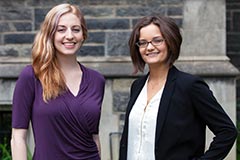Doctoral candidate blends love of science and art
By Betty Zou
Catherine Schrankel has a confession to make: “I’ve always been secretly artistic,” says the PhD student studying immune system evolution and development in the lab of Dr. Jonathan Rast at Sunnybrook Research Institute. She is putting her hidden creative talents to good use as the co-editor-in-chief of the University of Toronto department of immunology’s flagship publication IMMpress Magazine.
Schrankel joined the magazine as a writer in 2013, shortly after it was launched by students Yuriy Baglaenko and Charles Tran. “I really enjoyed interviewing alumni and current students and teasing apart the stories behind the science,” she says. Schrankel and co-editor Kieran Manion took the helm in December 2014. Together, they manage the administrative and editorial aspects of the publication with Schrankel taking on the additional role of design director.
Eight months into her tenure, Schrankel speaks with Betty Zou about her creative outlet and how it keeps her going on and off the lab bench.
Where does your interest in science communications and illustration come from?
I’ve always liked art and creativity. I think science in itself can be very creative in designing the right experiments and putting everything together. Working with the magazine as a writer, I really enjoyed getting to know [what happens] ‘behind the scenes’ of science and telling an interesting story.
I’ve always worked in basic science. I know why it’s incredibly important and why I love discovery-based science, but I don’t think the public understands it as well. I find science communications is a good vehicle to promote a holistic approach to science.
How do you choose the themes and topics for each issue?
The magazine runs four issues per year, each with a unique scientific theme. When Kieran and I started as co-editors, we literally sat at a pub, had a beer and brainstormed our first year of themes. A few important ideas came out of that session and we narrowed them down to four.
We cover a mix of research and popular science news, alumni interviews and what we think is interesting. I personally push for comparative or evolutionary research to be somewhere in every issue. We also try to stay on trend and pick topics before they become the next big thing. For example, there’s going to be a piece in the next issue about cats, specifically the viral Kickstarter campaign to fund the sequencing and analysis of cat gut microbiomes.
Which do you enjoy more—writing or designing?
It depends. I do like writing, especially when it involves interviewing or it’s about something that the department isn’t as familiar with, and I have to find a way to make it interesting and relevant. For the design part, it’s just a really great feeling to see the concept of an article translated into a layout. It’s hard to separate the two, especially when I design my own articles.
As the design director, what inspires you?
Definitely other journal articles and design resources. If you’re interested in design, some of the best preparation is flipping through periodicals and seeing what speaks to you in layout. What do you see that you like? Do you like certain colours or placements? Why was it so interesting to you? I learned to ask those questions from the original design director, Charles Tran. I also found a lot of design books very helpful in identifying how to move from a concept to a picture or a layout. We’ll also brainstorm as a team, so if someone has an idea we’ll talk about it and then it kind of nucleates and other ideas come forth.
Is it hard juggling being a co-editor with full-time graduate studies?
Yes. It definitely took some time to figure out the balance—it’s difficult but it’s also very rewarding and worthwhile. As a scientist, sometimes you get irritated doing the same experiments over and over again. It’s nice to be able to take a break from that and work on the magazine for a little bit. At the same time, after sitting at a computer for 10 hours, it’s nice to go back to the bench. They complement each other in that way.
How has your experience with the magazine benefited your graduate experience?
First of all, I’ve become more involved with the department itself. There’s been a lot of friendships and working relationships with the students on our team, especially my co-editor Kieran. Second, I think there’s a time in everybody’s PhD, especially toward the end, where you get in a rut and you’re close to being burned out. While it’s a lot of work, the magazine saved me from getting so burned out that I didn’t want to finish my PhD. It helps me to think more about what I want to do as a scientist and opens up another avenue for careers down the line, should I ever want to leave academia completely.
For more information about IMMpress Magazine and to learn more about how to get involved, please visit www.immpressmagazine.com or contact the editors at editor@immpressmagazine.com or Schrankel at c.schrankel@mail.utoronto.ca.






